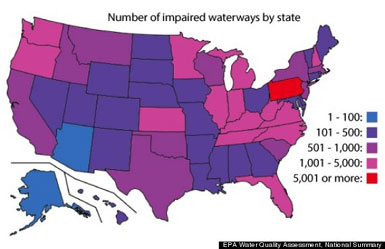Now that the water crisis in Flint, Michigan has become a national news story, plenty of other communities are examining the health of their drinking water resources and it’s not a pretty picture.
Take Iowa, for example. 500,000 people in Des Moines get their drinking water from a river, and like Flint, it is more polluted than federal standards allow but for different reasons. In Iowa, the problem is nitrate pollution from the over-abundance of fertilizers used in corn country and the millions of animals confined in factory farms.
260 towns and cities have the same problem in Iowa – in other words, polluted drinking water affects most of the state, says Richard Manning in Harpers. Nothing like drinking a combination of nitrogen fertilizer, pesticides, and manure … Yum!

You might ask, aren’t there environmental laws that protect this drinking water? In fact, there are not. The EPA only regulates water that flows from a pipe into a river, from factories, for example, but has no authority over "nonpoint" pollution – which can’t be attributed to any one source.
"Nationwide, any river or stream that wends through farm country suffers pollution to the point of death, but in the Upper Midwest, the plague is nearly total," says Manning.
These are the same fertilizers that travel down the Mississippi River and end up in the Gulf of Mexico, causing the infamous dead zones. Iowa contributes 25% of that pollution, notes Manning.
Read our article, 12 States Work to Shrink Gulf of Mexico Dead Zone.
While it didn’t make national news, citizens in Toledo, Ohio couldn’t drink the water in 2014 after fertilizers caused toxic algae blooms, Manning points out. What did Ohio Governor John Kasich do? He called in the National Guard to distribute bottled water and signed a "palliative bill endorsed by Big Ag" that did nothing to prevent it from happening again.
Last year, when EPA introduced the "Waters of the United States" rule to clarify oversight of rivers that supply drinking water for a third of Americans, Republicans passed legislation to stop this "massive overreach." President Obama vetoed it.
And when EPA tried to gain some control over factory farm waste flowing into rivers, Iowa Governor Bransted simply cut the budget for state inspectors, says Manning.
Meanwhile, Iowa utility Des Moines Water Works has spent over $1 million to filter nitrates out of the water, but "the level and persistence of the pollution have repeatedly overwhelmed the equipment," says Manning. If filtration doesn’t work, the utility faces about $180 million for upgraded equipment.
It’s not as if these problems can’t be fixed. Instead of allowing farm runoff to directly enter waterways, it can be routed into pastures and wetlands that treat the water naturally. Manning says that just 10 acres of wetland can treat runoff from 1000 acres of corn.
Some farmers are moving in this direction. Read our article, Farmers Turn to Floating Islands to Cut Pollution.
Farmers can also reduce fertilizer use, of course. "If 40% of cropland claimed by corn were planted with other crops and permanent pasture, the whole litany of problems caused by industrial agriculture – certainly the nitrate pollution of drinking water – would begin to evaporate. There are no technological or financial hurdles to implementing this program, but there is a political obstacle: the federal government would have to stop subsidizing growing corn. Between 1995-2012, those subsidies amounted to $84 billion," says Manning.
In the latest ranking of how well countries protect their environmental resources, the US comes in #26.
Read the full Harpers article, which gets into the issue of growing corn for ethanol, The Trouble with Iowa: Corn, Corruption, and the Presidential Caucuses:
